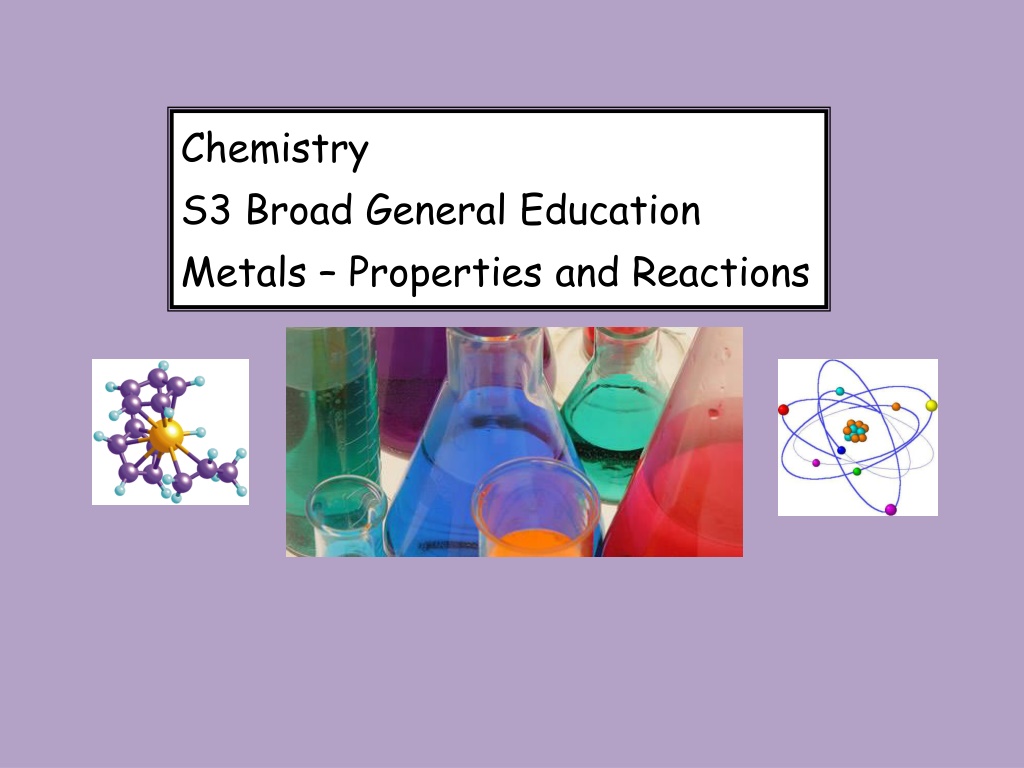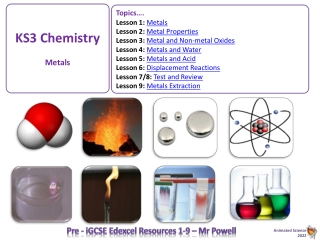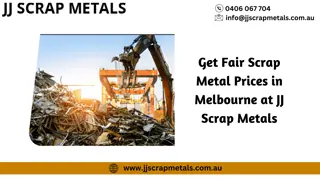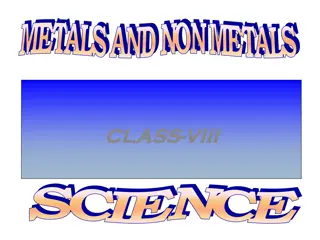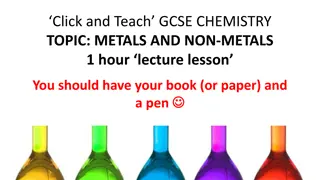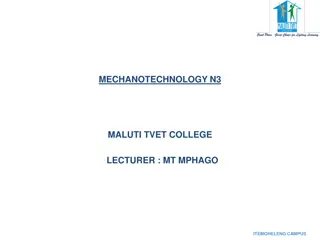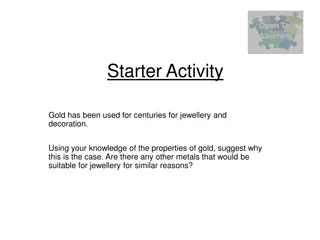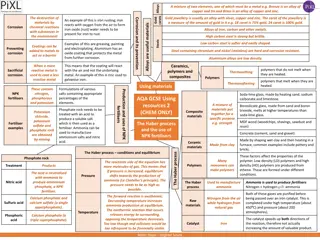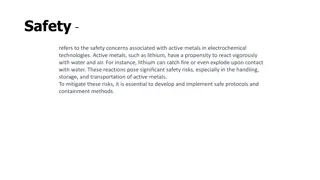Understanding Metals: Properties, Reactions, and Applications
Metals exhibit unique properties such as conductivity, metallic bonding, and reactivity with acids. They can be combined to form alloys with enhanced characteristics. This overview covers the properties, reactions, and utility of metals in various applications, providing insights into their behavior in different environments.
Download Presentation

Please find below an Image/Link to download the presentation.
The content on the website is provided AS IS for your information and personal use only. It may not be sold, licensed, or shared on other websites without obtaining consent from the author. Download presentation by click this link. If you encounter any issues during the download, it is possible that the publisher has removed the file from their server.
E N D
Presentation Transcript
Chemistry S3 Broad General Education Metals Properties and Reactions
Properties of Metals A property of a substance is a feature or an attribute that the substance has. For example: Iron = very strong Copper = doesn t rust Gold = nice colour!
Conduction Metals can conduct both heat and electricity. This is because all metal atoms have free electrons (delocalised electrons) which can move from one atom to the next. eee e This lets the heat and electricity move . Metallic
Metallic Bonding & Structure Most elements in the Periodic Table are metals. Atoms of metal elements bond by METALLIC BONDING. A metallic structure exists of a giant lattice of positively charged ions and delocalised (free) outer electrons.
Alloys To change the properties of metals they can be mixed with other metals (or carbon). These are known as ALLOYS. Examples include: Steel iron & carbon (increase strength) Stainless steel iron, chromium & nickel (resists rusting) Solder lead & tin (melts at low temperature) Alloys
Reactivity Series Chemists can study many different reactions to work out a REACTIVITY SERIES A Reactivity Series is a league table of how easily metals react with the most reactive at the top.
Reactivity Series potassium sodium lithium calcium magnesium aluminium zinc iron tin lead copper mercury silver gold Most Reactive Least Reactive
Reaction of Metals with Acids How to collect your gas: Delivery tube Stopper http://upload.wikimedia.org/wikipedia/commons/9/93/Scheme_of_eudiometr.png Upside down test-tube full of water 20 cm3 Sulfuric Acid 2 strips of Magnesium Tub of water Once you have collected your gas, try and identify it.
Reaction of Metals with Acids When acids react with metals, they produce HYDROGEN gas.
Reactivity Series potassium sodium lithium calcium magnesium aluminium zinc iron tin lead copper mercury silver gold Most Reactive React with acid Least Reactive
Reaction of Metals with Acids All metals ABOVE COPPER in the Reactivity Series will react with acid. Metal + Acid Salt + Hydrogen Magnesium + Hydrochloric Magnesium + Hydrogen Acid Chloride (this is similar to a neutralisation reaction you did in S2) Separating Salts Separating Salts
What is a Salt? Salts are compounds which are made when acids react. Have you seen other substances which will React with an acid? Acids can react with: Metals Alkalis Metal Carbonates Metal Oxides All these reactions will produce a SALT.
Naming Salts When salts are named: the first part of the name comes from the METAL the second part from the ACID Example: Hydrochloric acid + Sodium = Sodium chloride
Naming Salts If the acid is hydrochloric then the salt will be a chloride. If the acid is sulfuric the salt will be a sulfate. If the acid is nitric then the salt will be a nitrate. Put the information in red, above, into a simple table so that you will remember it!
N5 Reaction of Metals with Oxygen When metals react with oxygen they make an oxide: Metal + Oxygen Metal oxide Magnesium + Oxygen Aluminium + Oxygen
Reactivity Series potassium sodium lithium calcium magnesium aluminium zinc iron tin lead copper mercury silver gold Most Reactive React with acid React with oxygen Least Reactive
Flame tests When compounds containing metals are placed in a flame, they burn with a distinctive colour. Metal Flame colour Flame Testing Flame Testing
Flame tests Chemists can use the colour of the flame to tell which metals are present in the compound.
Extracting Metals Metals exist in the earth s crust as METAL ORES, the natural compound which they exist as. Normally they are found as the oxide (like iron oxide) but sometimes as carbonates (like copper carbonate). http://gwydir.demon.co.uk/jo/minerals/malachite.jpg http://s.hswstatic.com/gif/iron-3.jpg
Extracting Metals Metals are extracted from their ores in different ways, depending on the REACTIVITY of the metal. (More reactive metals are harder to separate from their ores.) Extracting Metals
Extracting Metals Summary potassium sodium lithium calcium magnesium aluminium zinc iron tin lead copper mercury silver gold Most Reactive Electrolysis (using electricity) Heat and carbon Heat alone Least Reactive
N5 Electrolysis Electrolysis is the breaking up of compounds using electricity Negative electrode Positive electrode - - + - Solution + + + - When a DC current is turned on (ie turn on the power pack), the charged particles move towards the electrode with the opposite charge: METALS (POSITIVE) NON-METALS (NEGATIVE) NEGATIVE ELECTRODE POSITIVE ELECTRODE
Making Electricity When pairs of metals are connected together with an electrolyte (a solution) an electric current will flow. Voltmeter V zinc copper Lemon juice acts as an ELECTROLYTE In chemistry, this is known as a CELL (but you may call it a battery).
Cell (or Battery) V Metal A Metal B Electrolyte (salt solution) In chemistry, this is known as a CELL (but you may call it a battery) An ELECTROLYTE is needed to COMPLETE THE CIRCUIT.
A Simple Cell V Metal A Metal B Electrolyte (ionic solution) A cell must consist of: and an 2 DIFFERENT METALS ELECTROLYTE An ELECTROLYTE is a solution containing IONS (charged particles)
Electrochemical Series Different pairs of electrodes (metals) produce different voltages. Using the different voltages produced, metals can be organised into a league table (similar to the Reactivity Series). This is known as an ELECTROCHEMICAL SERIES.
Electrochemical Series Reactive metals are more likely to make electrons (electricity). If you paired aluminium and calcium together which is going to make electrons?
A Simple Cell V Metal A Metal B Electrolyte (ionic solution) Metals vary in their ability to PRODUCE electrons. If METAL A is better at producing electrons than METAL B, the electrons will move from A to B.
Electrochemical Series Rules for connecting metals: The further apart the metals are in the series, the higher the voltage produced Mg + Al create a lower voltage than Mg + Cu Electrons ALWAYS flow from a metal HIGHER in the series to a metal LOWER Mg down to Al (NOT Al up to Mg)
Flow of Charged Particles Electrons flow through the wire from Mg to Cu V Magnesium Copper Electrolyte (ionic solution) Ions flow between the electrodes
Electrolyte An electrolyte is a solution, which contains IONS (charged particles). An electrolyte completes the circuit, and allows electricity to be produced. At a high concentration there are many more ions, which lets more electricity be produced.
More Complicated Cells V Magnesium Copper Salt Bridge Electrolytes (solution) When there are two half cells, an SALT BRIDGE is used to complete the circuit.
Writing Chemical Formula The CHEMICAL FORMULA tells us the number of ATOMS of EACH ELEMENT which are in a compound. This molecule has 8 x carbon atoms 10 x hydrogen atoms 4 x nitrogen atoms 2 x oxygen atoms
Writing Chemical Formula Tells us: type of atoms number of atoms In a substance For Example: Na Cl : Contains 1 sodium atom, 1 chlorine atom Li2SO4 : Contains 2 lithium atoms, 1 sulphur atom, 4 oxygen atoms Ca(OH)2 : Contains 1 calcium atom, 2 oxygen atoms, 2 hydrogen atoms
Calculating Formulae There are 3 different ways to work out formulae depending on the name of the substance. 1. Models / Structures
Chemical Formula Octane Formula = C8H18 Hydrogen Peroxide Formula = H2O2 Formula = CH5N or CH3 NH2 Formula = C6 H12 Methylamine Cyclohexane
Sucrose Formula = C12H22 O11
2. Using Prefixes These rules can only be used if the substance name has a prefix in it such as mono, di, tri, etc Nitrogen monoxide A. 1 nitrogen 1 oxygen Formula =NO
Diphosphorous trichloride B. 2 phosphorous 3 chlorine Formula = P2Cl3
Prefixes If the name of the compound contains a PREFIX then we simply write what the name tells us! Prefix Mono Di Tri Tetra Penta Hexa Meaning one two three four five six
Valency Rule VALENCY tells us HOW MANY ATOMS an element will combine with The valency of most elements can be determined from their GROUP Group Number 1 2 3 4 5 6 7 0 Valency 1 2 3 4 3 2 1 0 This mean that all elements in GROUP 1 have a VALENCY of 1 all elements in GROUP 6 have a VALENCY of 2
Reminder: Valency Rule This rule uses the valency of the elements to work out how many atoms will combine Carbon Hydride C H 4 1 1 C1 4 H4 Formula =CH4
Transition Metals The TRANSITION METALS do not have a fixed Valency. Their VALENCY is indicated by the ROMAN NUMERAL in their name. BUT we still use the VALENCY RULE to get their formula. Example 1: Copper (I) oxide & Copper (II) oxide Example 2: Iron (II) chloride & Iron (III) chloride
Gram Formula Mass Mass is how much something weighs. The mass of a compound can be found by adding together the mass of all the atoms in the compound s formula. (The mass of each element is found in the data table!)
Questions Gram Formula Mass To find the formula mass, you add together the mass of each atom. Example 1: CCl4 Example 2: MgCl2
Electron Arrangement How many protons and electrons would be in these atoms? (1) Sodium (6) Aluminium (2) Oxygen (7) Sulfur (3) Helium (8) Calcium (4) Nitrogen (9) Potassium (5) Chlorine (10) Neon Extra: Do you know how the electrons are arranged around the nucleus???
Electron Arrangement Electrons orbit (move around) in specific paths (energy levels) around the nucleus of the atom. Each energy level can hold a maximum number of electrons. 1st Energy Level (holds max 2 electrons) 2nd Energy Level (holds max 8 electrons) Nucleus 3rd Energy Level (holds max 8 electrons) Could you draw the electron arrangements of the atoms from the previous slide?
Ions Ions are particles where the number of protons and electrons are not equal. Ions form when atoms lose or gain electrons (they do this to have a full outer level, and become stable!) The number of electrons depends on the VALENCY of the element. Group Number 1 2 3 4 5 6 7 0 Valency 1 2 3 4 3 2 1 0
Ions Metals: Metal atoms ALWAYS LOSE electrons to form POSITIVE IONS. eg Sodium Sodium is in Group 1 and has a VALENCY 1 so loses 1 electron The charge is written beside the element symbol: Na+ (a 1+ charge)
Ions Non-Metals: Non-metal atoms ALWAYS GAIN electrons to form NEGATIVE IONS. eg Chlorine Chlorine is in GROUP 7 and has a VALENCY 1 so gains 1 electron: Cl- (a 1- charge)
